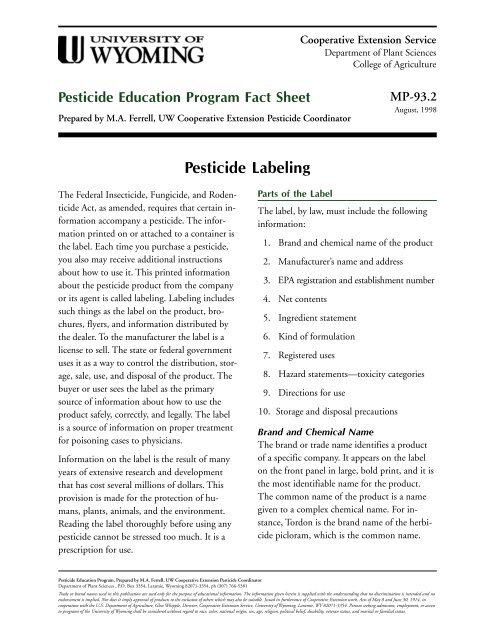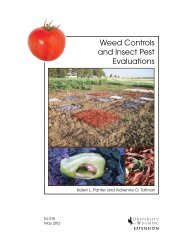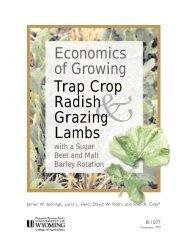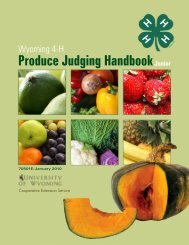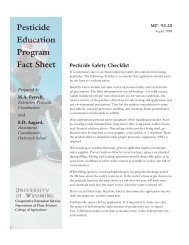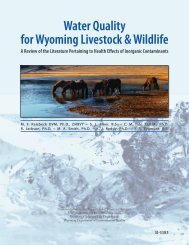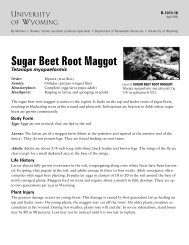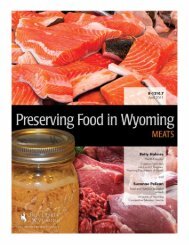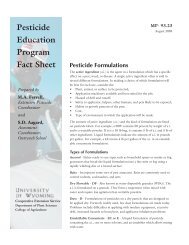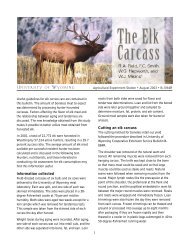Pesticide Labeling
Pesticide Labeling
Pesticide Labeling
Create successful ePaper yourself
Turn your PDF publications into a flip-book with our unique Google optimized e-Paper software.
Cooperative Extension Service<br />
Department of Plant Sciences<br />
College of Agriculture<br />
<strong>Pesticide</strong> Education Program Fact Sheet<br />
Prepared by M.A. Ferrell, UW Cooperative Extension <strong>Pesticide</strong> Coordinator<br />
MP-93.2<br />
August, 1998<br />
<strong>Pesticide</strong> <strong>Labeling</strong><br />
The Federal Insecticide, Fungicide, and Rodenticide<br />
Act, as amended, requires that certain information<br />
accompany a pesticide. The information<br />
printed on or attached to a container is<br />
the label. Each time you purchase a pesticide,<br />
you also may receive additional instructions<br />
about how to use it. This printed information<br />
about the pesticide product from the company<br />
or its agent is called labeling. <strong>Labeling</strong> includes<br />
such things as the label on the product, brochures,<br />
flyers, and information distributed by<br />
the dealer. To the manufacturer the label is a<br />
license to sell. The state or federal government<br />
uses it as a way to control the distribution, storage,<br />
sale, use, and disposal of the product. The<br />
buyer or user sees the label as the primary<br />
source of information about how to use the<br />
product safely, correctly, and legally. The label<br />
is a source of information on proper treatment<br />
for poisoning cases to physicians.<br />
Information on the label is the result of many<br />
years of extensive research and development<br />
that has cost several millions of dollars. This<br />
provision is made for the protection of humans,<br />
plants, animals, and the environment.<br />
Reading the label thoroughly before using any<br />
pesticide cannot be stressed too much. It is a<br />
prescription for use.<br />
Parts of the Label<br />
The label, by law, must include the following<br />
information:<br />
1. Brand and chemical name of the product<br />
2. Manufacturer’s name and address<br />
3. EPA registration and establishment number<br />
4. Net contents<br />
5. Ingredient statement<br />
6. Kind of formulation<br />
7. Registered uses<br />
8. Hazard statements—toxicity categories<br />
9. Directions for use<br />
10. Storage and disposal precautions<br />
Brand and Chemical Name<br />
The brand or trade name identifies a product<br />
of a specific company. It appears on the label<br />
on the front panel in large, bold print, and it is<br />
the most identifiable name for the product.<br />
The common name of the product is a name<br />
given to a complex chemical name. For instance,<br />
Tordon is the brand name of the herbicide<br />
picloram, which is the common name.<br />
<strong>Pesticide</strong> Education Program, Prepared by M.A. Ferrell, UW Cooperative Extension <strong>Pesticide</strong> Coordinator<br />
Department of Plant Sciences , P.O. Box 3354, Laramie, Wyoming 82071-3354, ph (307) 766-5381<br />
Trade or brand names used in this publication are used only for the purpose of educational information. The information given herein is supplied with the understanding that no discrimination is intended and no<br />
endorsement is implied. Nor does it imply approval of products to the exclusion of others which may also be suitable. Issued in furtherance of Cooperative Extension work, Acts of May 8 and June 30, 1914, in<br />
cooperation with the U.S. Department of Agriculture, Glen Whipple, Director, Cooperative Extension Service, University of Wyoming, Laramie, WY 82071-3354. Persons seeking admission, employment, or access<br />
to programs of the University of Wyoming shall be considered without regard to race, color, national origin, sex, age, religion, political belief, disability, veteran status, and marital or familial status.
The chemical name is 4-amino-3,5,6-<br />
trichloropicolinic acid. A pesticide made by<br />
more than one company is sold under several<br />
brand names, but all of them have the same<br />
common name or chemical name.<br />
Manufacturer’s Name and Address<br />
The law requires that the product’s maker or<br />
distributor put the company’s name and address<br />
on the label so you will know who made<br />
or sold the product.<br />
Registration and Establishment Number<br />
A registration number must be on every pesticide<br />
label. An EPA number shows that the<br />
product has been registered with the federal<br />
government. It usually is found on the front<br />
panel of the label and is written as “EPA Registration<br />
No. 0000.” A number assigned to the<br />
establishment where the product is manufactured<br />
must also appear. In cases of special local<br />
needs, pesticide products may be approved by a<br />
state. These registrations are designated, for example,<br />
as EPA SLN No. WY-800004. In this<br />
case, SLN indicates “special local need,” WY-<br />
800004 means the product is registered for use<br />
in Wyoming, was registered in 1980, and was<br />
the fourth special needs product registered in<br />
the state that year.<br />
Net Contents<br />
The net contents number tells you how much<br />
is in the container. If the product is liquid, it<br />
must be stated in liquid measure terms (gallons,<br />
quarts, pints, and fluid ounces). If the product<br />
is a powder or granule, it is stated in terms of<br />
weight (pounds and ounces).<br />
Ingredient Statement<br />
Every pesticide label must list what is in the<br />
product. The amount of each active ingredient<br />
is given as a percentage by weight and as<br />
pounds per gallon of concentrate. It can be<br />
listed by either the chemical name or the common<br />
name. The inert ingredients need not be<br />
named, but the label must show what percent<br />
of the contents they make up.<br />
Kind of Formulations<br />
The basic chemical used to control pests must<br />
be formulated with other materials such as solvents,<br />
emulsifiers, surfactants, powders, granules,<br />
and dusts. The formulation is listed on the<br />
label as an emulsifiable concentrate, wettable<br />
powder, granules, fumigant, and so on. The<br />
same pesticide may be available in more than<br />
one formulation. Formulations, for example,<br />
may be designated on the label as 7E (7 pounds<br />
per gallon emulsifiable liquid), 50-WP (50 percent<br />
wettable powder) or 10-G (10 percent<br />
granular).<br />
Registered Uses<br />
The label must include what specific pests the<br />
pesticide controls, what crops or animals it can<br />
be used on, and the classification of uses. Every<br />
pesticide label must show whether the contents<br />
are for general use or restricted use. The<br />
pesticide’s classification depends on its toxicity<br />
(hazard of poisoning), the way in which it is<br />
used, and its effect on the environment.<br />
General-use pesticides may be applied by the<br />
general public without restriction, other than<br />
those specified on the label.<br />
Restricted-use pesticides require controls in<br />
addition to label instructions because they may<br />
have unreasonable adverse effects on the environment<br />
or injure the applicator; even when<br />
applied in accordance with directions for use,<br />
warnings, and cautions; or when used in accordance<br />
with a widespread or commonly recognized<br />
practice. Labels for restricted-use prod-<br />
2
ucts must state at the top of the front panel,<br />
“Restricted-use pesticide for retail sale to and<br />
application only by certified applicators or persons<br />
under their direct supervision.”<br />
Hazard Statements<br />
All pesticide labels must have the statement,<br />
“Keep Out of the Reach of Children.” They are<br />
grouped according to their toxicity to people, animals,<br />
and the environment. You can determine<br />
the toxicity of a product by reading the signal<br />
word and looking at the symbol on the label.<br />
Group<br />
I<br />
II<br />
III<br />
Signal<br />
word<br />
Danger-<br />
Poison<br />
Warnin g<br />
Caution<br />
Toxicity<br />
Highly<br />
toxic<br />
Moderatly<br />
toxic<br />
Slightly<br />
toxic<br />
Approximate<br />
amount to kill an<br />
average person<br />
Taste to teaspoon<br />
Teaspoon to<br />
tablespoon<br />
Ounce to one pint<br />
Highly toxic materials have a skull and<br />
crossbones symbol plus the signal word “Danger”<br />
and the word “Poison.” Warning statements<br />
appear on the label if the product can<br />
poison humans and animals. The label also tells<br />
you of any special steps you should take to<br />
avoid poisoning, such as the kind of protective<br />
equipment needed.<br />
Precautionary statements are on the label to<br />
protect the environment from pesticide contamination.<br />
For example, products toxic to<br />
bees will carry a warning statement on exposure<br />
from direct treatment or residue in crops.<br />
Warning statements also appear on the label to<br />
prevent people from contaminating water by<br />
cleaning their equipment, disposing of wastes,<br />
or applying pesticides where runoff is likely to<br />
occur. Statements also appear to remind the<br />
pesticide user against harming birds, fish, and<br />
wildlife.<br />
Highly toxic pesticides must have appropriate<br />
warning statements about symptoms of poisoning<br />
if the product is swallowed or inhaled. Information<br />
on antidotes and instructions to call<br />
a physician in an emergency will be included. A<br />
warning statement also must appear if the<br />
product can irritate the skin, nose, throat, or<br />
eyes.<br />
Directions for Use<br />
<strong>Pesticide</strong> labels must include instructions on<br />
how to use the pesticide and must be adequate<br />
to protect the user and the public. The use instructions<br />
should indicate how to apply the<br />
product correctly, when the product can be applied,<br />
and at what rate it should be applied. If<br />
required for the product, the label should indicate<br />
the waiting period—the number of days<br />
between treatment and harvest—and re-entry,<br />
the amount of time that must pass before a person<br />
can safely enter a pesticide-treated area<br />
without protective clothing.<br />
The label states that it is a violation of federal<br />
law to use a pesticide and must be adequate to<br />
protect the user and the public. The use instructions<br />
should indicate how to apply the<br />
product correctly, when the product can be applied,<br />
and at what rate it should be applied. If<br />
required for the product, the label should indicate<br />
the waiting period—the number of days<br />
between treatment and harvest—and re-entry,<br />
the amount of time that must pass before a person<br />
can safely enter a pesticide-treated area<br />
without protective clothing.<br />
The label states that it is a violation of federal<br />
law to use a product in a manner inconsistent<br />
with its directions. It is illegal to apply a pesti-<br />
3
cide to a crop or site not listed on the label. If<br />
applied to a pest not included on the label, the<br />
applicator is responsible for the results of that<br />
application. Some pesticide labels indicate use<br />
is limited to certain categories of commercial<br />
applicators.<br />
Some directions for use that pesticide users<br />
must obey are contained in documents that are<br />
only referred to on the labeling. Such instructions<br />
include EPA or other government regulations<br />
or requirements concerning the safe use<br />
of the pesticide product. For example, EPA has<br />
adopted or is considering new requirements<br />
concerning: groundwater protection; endangered<br />
species protection; pesticide transportation,<br />
storage, and disposal; and worker protection.<br />
One sentence or paragraph may be the<br />
only notice you will receive that additional use<br />
directions are required in order for the product<br />
to be used in compliance with its labeling. You<br />
must determine whether you are affected, locate<br />
the applicable directions for use, determine<br />
how to comply with the instructions and requirements<br />
in the directions for use, and comply<br />
with those instructions and requirements.<br />
Most documents referred to on the label should<br />
be available at your local county Cooperative<br />
Extension office.<br />
Storage and Disposal Precautions<br />
Every pesticide should be stored and discarded<br />
correctly. The label has directions for storing<br />
the pesticide to prevent contamination of other<br />
products. Storage temperatures are stated on<br />
the label to prevent overheating or freezing.<br />
The label either explains procedures for disposing<br />
empty containers or tells the user to follow<br />
procedures designated by state law. Directions<br />
on how to dispose of waste when rinsing equipment<br />
and containers also are included.<br />
Reading the Label<br />
Before you buy a pesticide, read the label to<br />
determine:<br />
· whether it is the pesticide you need for the<br />
specific crop and pest<br />
· whether the pesticide can be used safely under<br />
the application conditions<br />
Before you mix the pesticide, read the label to<br />
determine:<br />
· what protective equipment you should use<br />
· what the pesticide can be mixed with (compatibility)<br />
· how much pesticide to use<br />
· the mixing procedure<br />
Before you apply the pesticide, read the label to<br />
determine:<br />
· what safety measures you should follow<br />
· whether protective clothing and equipment<br />
are needed<br />
· where the pesticide can be used (livestock,<br />
crops, structures, as examples)<br />
· when to apply the pesticide (including the<br />
waiting period for crops and animals)<br />
· how to apply the pesticide<br />
· whether there are any restrictions for use of<br />
the pesticide<br />
Before you store or dispose of the pesticide or<br />
pesticide container, read the label to determine:<br />
· where and how to store the pesticide<br />
· how to decontaminate and dispose of the<br />
pesticide container<br />
· where to dispose of surplus pesticides<br />
If you have trouble reading or understanding<br />
the pesticide labeling, contact your local<br />
county Cooperative Extension Office or other<br />
knowledgeable person.<br />
4


